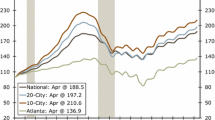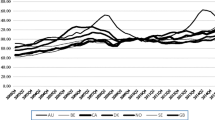Abstract
This study provides fresh implications for the puzzle of the recent housing boom-bust cycle in the United States. It extracts housing factors from housing price and volume time series at state and regional levels under a dynamic factor model, which considers three varieties of structural instability in local housing markets. The findings suggest that state-level housing price cycles are more unstable than housing volume cycles, and the probability of rejecting stability for the Northeast is the highest among four regional housing markets. In general, the housing market forecasts based on 1988–2012 full-sample factors and time-varying coefficients across pre- and post-1999 subperiods are superior to alternatives. The factor-based forecast results provide new evidence for a nationwide housing crisis in 2007–2008, and thus suggest possible effectiveness of monetary policies in stabilizing recent housing boom-bust cycles.
Similar content being viewed by others
Notes
This study uses housing starts to proxy for housing volumes of 51 states and 4 Census regions in the US.
The examples are MSAs in New York, Massachusetts and California, as noted by the authors.
Because state-level housing price and starts are available monthly but regional data are available only quarterly, quarterly values of state-level time series are computed by averaging the monthly values over the corresponding quarter.
Housing starts in DC are zero in most periods from 1995 to 1997, and thus the model excludes its housing volume.
MA is the only exception whose MSE ratio of split-split/full-split is less than unity (0.90) after 1999.
They examine how the recent recession in 2007–2009 differs from the previous business cycles under a dynamic factor framework, and they find no new common factor of macroeconomic variables in the post-2007 period. Hence, they suggest the recent recession results from larger versions of old economic shocks rather than unpredicted new ones.
References
Akay, O., Senyuz, Z., & Yoldas, E. (2013). Hedge fund contagion and risk-adjusted returns: A Markov-switching dynamic factor approach. Journal of Empirical Finance, 22, 16–29.
Akkoyun, H. C., Arslan, Y., & Kanik, B. (2013). Housing prices and transaction volume. Journal of Housing Economics, 22(2), 119–134.
Baffoe-Bonnie, J. (1998). The dynamic impact of macroeconomic aggregates on housing prices and stock of houses: A national and regional analysis. Journal of Real Estate Finance and Economics, 17(2), 179–197.
Bai, J., & Ng, S. (2002). Determining the number of factors in approximate factor models. Econometrica, 70(1), 191–221.
Baltagi, B. H., & Li, J. (2014). Further evidence on the spatio-temporal model of house prices in the United States. Journal of Applied Econometrics, 29(3), 515–522.
Banerjee, A., Marcellino, A. M., & Masten, I. (2008). Forecasting macroeconomic variables using diffusion indexes in short samples with structural change. In D. Rapach & M. Wohar (Eds.), Forecasting in the presence of structural breaks and model uncertainty. Bingley: Emerald Group.
Berger, T., & Pozzi, L. (2013). Measuring time-varying financial market integration: An unobserved components approach. Journal of Banking & Finance, 37(2), 463–473.
Boysen-Hogrefe, J. (2013). A dynamic factor model with time-varying loadings for euro area bond markets during the debt crisis. Economics Letters, 118(1), 50–54.
Breitung, J., & Eickmeier, S. (2011). Testing for structural breaks in dynamic factor models. Journal of Econometrics, 163(1), 71–84.
Campbell, J. Y., & Cocco, J. F. (2007). How do house prices affect consumption? Evidence from micro data. Journal of Monetary Economics, 54(3), 591–621.
Clayton, J., Miller, N., & Peng, L. (2010). Price-volume correlation in the housing markets: Causality and co-movements. Journal of Real Estate Finance and Economics, 40(1), 14–40.
Cordis, A. S., & Kirby, C. (2011). Regime-switching factor models in which the number of factors defines the regime. Economics Letters, 112(2), 198–201.
Crawford, G. W., & Fratantoni, M. C. (2003). Assessing the forecasting performance of regime-switching, ARIMA and GARCH models of house prices. Real Estate Economics, 31(2), 223–243.
Croce, R. M., & Haurin, D. R. (2009). Predicting turning points in the housing market. Journal of Housing Economics, 18(4), 281–293.
Del Negro, M., & Otrok, C. (2007). 99 luftballons: Monetary policy and the house price boom across U.S. States. Journal of Monetary Economics, 54(7), 1962–1985.
Edelstein, R. H., & Tsang, D. (2007). Dynamic residential housing cycles analysis. Journal of Real Estate Finance and Economics, 35(3), 295–313.
Fadiga, M. L., & Wang, Y. S. (2009). A multivariate unobserved component analysis of US housing market. Journal of Economics and Finance, 33(1), 13–26.
Flor, M. A., & Klarl, T. (2017). On the cyclicity of regional house prices: New evidence for U.S. metropolitan statistical areas. Journal of Economic Dynamics and Control, 77, 134–156.
Garcia-Martos, C., Rodriguez, J., & Sanchez, M. J. (2011). Forecasting electricity prices and their volatilities using unobserved components. Energy Economics, 33(6), 1227–1239.
Goodman, A. C., & Thibodeau, T. G. (2008). Where are the speculative bubbles in US housing markets? Journal of Housing Economics, 17(2), 117–137.
Hao, L., & Ng, E. C. Y. (2011). Predicting Canadian recessions using dynamic probit modelling approaches. Canadian Journal of Economics, 44(4), 1297–1330.
Hassani, H., Ghodsi, Z., Gupta, R., & Segnon, M. (2017). Forecasting home sales in the four Census regions and the aggregate US economy using singular spectrum analysis. Computational Economics, 49(1), 83–97.
Hendry, D. F., & Clements, M. P. (2004). Pooling of forecasts. Econometrics Journal, 7(1), 1–31.
Holly, S., Pesaran, M. H., & Yamagata, T. (2010). A spatio-temporal model of house prices in the USA. Journal of Econometrics, 158(1), 160–173.
Huang, M. (2013a). The role of people’s expectation in the recent US housing boom and bust. The Journal of Real Estate Finance and Economics, 46(3), 452–479.
Huang, M. (2013b). Housing bubble implications: The perspective of housing price predictability. Economics Bulletin, 33(1), 586–596.
Huang, M. C. (2014). Monetary policy implications of housing shift-contagion across regional markets. Journal of Economics and Finance, 38(4), 589–608.
Kim, S. W., & Bhattacharya, B. (2009). Regional housing prices in the USA: An empirical investigation of non- linearity. Journal of Real Estate Finance and Economics, 38(4), 443–460.
Koop, G., & Korobills, D. (2011). UK macroeconomic forecasting with many predictors: Which model forecast best and when do they do so? Economic Modelling, 28(5), 2307–2318.
Lai, R. N., & Van Order, R. (2010). Momentum and house price growth in the U.S.: Anatomy of a bubble. Real Estate Economics, 38(4), 753–773.
Leamer, E. E. (2007). Housing is the business cycle. NBER Working Paper No. 13248, National Bureau of Economic Research.
Lee, J. (2012). Measuring business cycle co-movements in Europe: Evidence from a dynamic factor model with time-varying parameters. Economics Letters, 115(3), 438–440.
Miles, M. (2015). Regional house price segmentation and convergence in the US: A new approach. Journal of Real Estate Finance and Economics, 50(1), 113–128.
Miller, N., Peng, L., & Sklarz, M. (2011a). House prices and economic growth. Journal of Real Estate Finance and Economics, 42(4), 522–541.
Miller, N., Peng, L., & Sklarz, M. (2011b). The economic impact of anticipated house price changes—Evidence from home sales. Real Estate Economics, 39(2), 345–378.
Moench, E., & Ng, S. (2011). A hierarchical factor analysis of U.S. housing market dynamics. Econometrics Journal, 14(1), C1–C24.
Ng, E. C. Y. (2012). Forecasting US recessions with various risk factors and dynamic probit models. Journal of Macroeconomics, 34(1), 112–125.
Oikarinen, E. (2012). Empirical evidence on the reaction speeds of housing prices and sales to demand shocks. Journal of Housing Economics, 21(1), 41–54.
Poncela, P., Rodriguez, J., Sanchez-Mangas, R., & Senra, E. (2011). Forecast combination through dimension reduction techniques. International Journal of Forecasting, 27(2), 224–237.
Rapach, D. E., & Strauss, J. K. (2009). Differences in housing price forecastability across US states. International Journal of Forecasting, 25(2), 351–372.
Shiller, R. J. (2006). Long-term perspectives on the current boom in home prices. Economists’ Voice, 3(4), 1–11.
Shiller, R. J. (2008). Understanding recent trends in house prices and homeownership. In Jackson Hole Conference Series (Ed.), Housing, housing finance and monetary policy (pp. 85–123). Kansas City, MO.
Silos, P., & Vilan, D. (2009). Is more still better? Revisiting the sixth district coincident indicator. Federal Reserve Bank of Atlanta Economic Review, 94(3), 1–8.
Stock, J. H., & Watson, M. W. (2002a). Macroeconomic forecasting using diffusion indexes. Journal of Business and Economic Statistics, 20(2), 147–162.
Stock, J. H., & Watson, M. W. (2002b). Forecasting using principal components from a large number of predictors. Journal of the American Statistical Association, 97(460), 1167–1179.
Stock, J. H., & Watson, M. W. (2007). Why has inflation become harder to forecast? Journal of Money, Credit, and Banking, 39(1), 3–33.
Stock, J. H., & Watson, M. W. (2008). Forecasting in dynamic factor models subject to structural instability. In J. Castle & N. Shephard (Eds.), The methodology and practice of econometrics, a festschrift in honour of Professor David F. Hendry. Oxford: Oxford University Press.
Stock, J. H., & Watson, M. W. (2009). The evolution of national and regional factors in U.S. housing construction. In T. Bollerslev, J. Russell, & M. Watson (Eds.), Volatility and time series econometrics: Essays in Honour of Robert F. Engle. Oxford: Oxford University Press.
Stock, J. H., & Watson, M. W. (2012). Disentangling the channels of the 2007–2009 recession. Brookings Papers on Economic Activity, 43(1), 81–156.
Topel, R., & Rosen, S. (1988). Housing investment in the United States. Journal of Political Economy, 96(4), 718–740.
Wit, E. R., Englund, P., & Francke, M. K. (2013). Price and transaction volume in the Dutch housing markets. Regional Science and Urban Economics, 43(2), 220–241.
Zaher, F. (2007). Evaluating factor forecasts for the UK: The role of asset prices. International Journal of Forecasting, 23(4), 679–693.
Author information
Authors and Affiliations
Corresponding author
Rights and permissions
About this article
Cite this article
Huang, M. A Nationwide or Localized Housing Crisis? Evidence from Structural Instability in US Housing Price and Volume Cycles. Comput Econ 53, 1547–1563 (2019). https://doi.org/10.1007/s10614-018-9822-9
Accepted:
Published:
Issue Date:
DOI: https://doi.org/10.1007/s10614-018-9822-9




